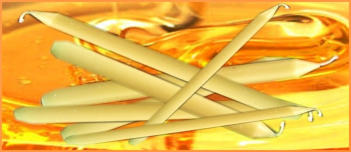From the Hives
of the Burrs and the Bees Comes
Beeswax Candles
Facts and History
Beeswax is a tough wax formed from a mixture of several compounds
secreted by honeybees in the form of thin scales from glands on the ventral
surface of the abdomen and used in building the combs in which the young
are raised and honey and pollen are stored. Its colour varies from yellowish-
white to brownish depending on purity. It has a high melting point,near 65°C.
Beeswax is used commercially to make fine candles, in polishing materials,
as a component of modeling waxes, and in a variety of other products.
Beeswax candles are preferred in many churches because they burn cleanly,
with little or no wax dripping down the sides and little visible smoke.
Beeswax candles burn clean, with a golden flame and a brilliant halo. The
halo is a result of a hotter burn. Beeswax burns longer and cleaner than
paraffin. Help to improve our environment by using beeswax in place of
petroleum based products.
100% beeswax burns clean and actually emits negative ions that clean the
air. It does not contain toxic petrochemicals and burns without soiling smoke
or soot.
Bloom
Why are some beeswax candles covered with a whitish residue?
Persons new to beeswax candles are often perplexed by the appearance of
a whitish deposit forming on their candles over time. This is called "bloom".
It is the action of the natural minerals rising to the candle surface. Some
people like bloom, as it is an assurance of high quality 100% beeswax and
gives the candle an antique appeal.
If a shinier surface or more contemporary look is preferred, simply wipe the
bloom off with a lint free cloth (nylon hosiery is perfect for this task) or
carefully warm it for a few seconds with a hair dryer or gently run it under
warm water.
What is the Proper Colour for Beeswax?
The colour of the wax depends on the source and the cleanliness. Beeswax
with a brownish or dull tint is usually old wax rendered or scraped from old
brood frames.
At the opposite end of the scale is the "cream" or "white" wax which may be
the result of bleaching or chemical filtering. Neither of these should be used
for candles. Beeswax when in a completely pure form is white in colour.
But, bees forage and bring nectar and pollen into the hive; this stains the
honeycomb to a golden colour. The intensity of this colour is affected by the
food currently available as pollen on the flowers in the area.
This can tinge the honeycomb to slightly lighter or darker shades, depending
upon the variety of pollens picked up by the bees. The honeycomb is also
scented by the particular honey that the bees are feeding from.
Is It Dripless?
100% Beeswax burns dripless if kept from draft and the candle is of a
consistent shape relative to the size of the wick. All tapers and plain pillars
possess this coveted quality.
When 100% Beeswax burns, it is consumed by the fire of the flame.
Other waxes disintegrate into toxic components and are released into the
room or melt into drippings.
Why do we make the extra effort to use 100% pure beeswax?
Because, you are breathing the same air in the rooms where the candles are
burning.

FROM THE HIVES OF
The Burrs and the Bees
FROM THE HIVES OF
The Burrs and the Bees



















